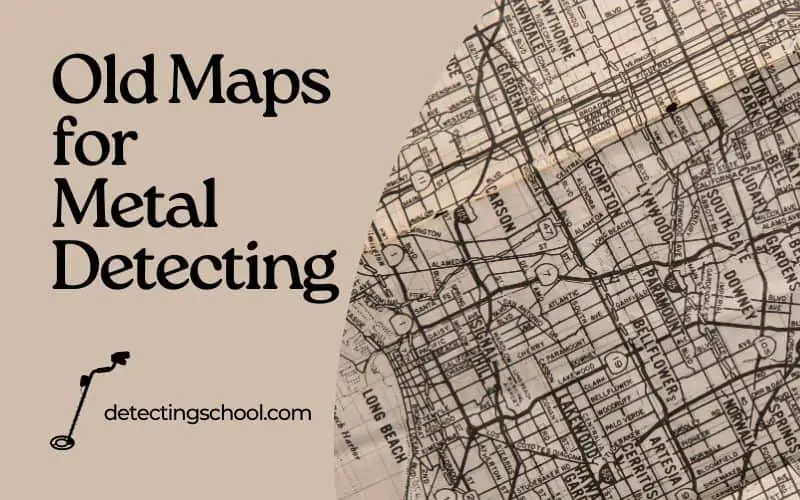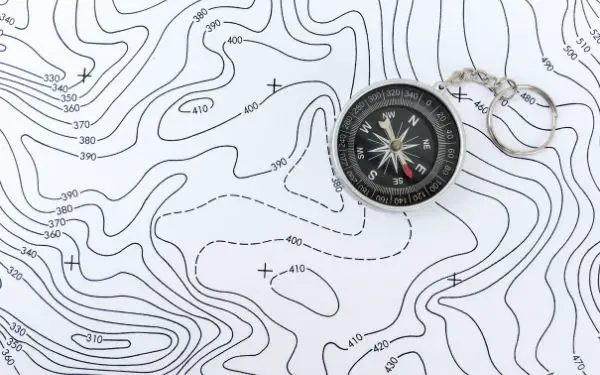
Old maps are a true treasure trove for metal detectorists & treasure hunters. They bring a huge potential by revealing hidden locations that could hold historical finds and valuable artifacts …
The real question now, is how and where you can find those old maps?!
In this article, I share some helpful tips & explain the process to find those valuable resources. This Post might be the most important one in this whole website …
Key Takeaways
- Old maps are critical for metal detecting. It can reveal historical lands, settlement patterns, and potential detecting sites.
- There are several types of old maps that you should be aware of. It is important to combine them with modern technology to maximize your chances to identify hidden treasure locations.
- When using old maps for metal detecting, it’s a necessity to follow some important ethical guidelines.
Why should you use old maps for metal detecting?
There are some detectorists who don’t really pay too much attention to the importance of old maps for this hobby. Obviously, they are wrong! Indeed …
- Old maps provide valuable & obscure information about historical lands & settlement patterns.
- They’ll help you pinpoint areas with the most potential for valuable finds. These include, homesites, trade routes as well as old gathering places.
- Antique maps can reveal places where people once lived and worked. This makes it easier for you to find relics and old coins (You can learn about the best places to find old coins while metal detecting)
- Those maps can help identify changes that took place in landscapes and waterways. This will reveal areas that were once popular in the past that are rarely visited now.
- These maps can help you avoid restricted areas or those that are under a private property. Thus, having a more enjoyable experience.
Types of old maps you should know about …
Not every old map should be used by detectorists! You first need to learn about the different types of maps and how each one can help you in your adventure. Below, are the most important types:

Topographic maps: They generally represent the earth’s surface features. They include things like elevation, terrain & human-made structures. In those maps you can find old roads, waterways as well as settlements. These are really valuable for metal detecting.
Plat maps: This one describes property divisions and land ownership; they also showcase the boundaries between those properties. You can take advantage of such a map to locate old homesites and farms where you might find old coins & relics.
Sanborn Fire Insurance maps: they represent fire risks and generally have details about building materials & constructions. These will help you locate old business and industrial sites where you can find buried artifacts.

Military maps: Mostly produced for military purposes. They can show locations of battles, camps along with fortifications. These could be useful for detectorists who are looking for artifacts like old ammunitions and weapons.
Important Tip: If you want to search for historical coins, relics & artifacts, then you should use a capable metal detector that can make it easier for you to pick up those finds. For example, this Quality Metal Detector is my favorite one where it comes to finding old artifacts.
Online resources for finding old maps
There are many online resources where you can find old maps that you can utilize for your metal detecting activities:
- Library of Congress: They offer a huge collection of historical maps. These include topographic, military as well as plat maps. You can check out their website.
- David Rumsey map collection: We are talking here about a very large online archive of historical maps. Many of those are high-resolution images that can make your detection quest much easier. You can check out their website.
- USGS Historical Topographic Map Explorer: It mostly include topographic maps across the US. If you are a US resident, then these will be extremely useful for you. You can check out their website.
- Historic Aerials: Where you can find interesting aerial photography and satellite imagery from different time periods. These are really useful to identify changes that have occurred in a given land/area overtime.
- Local libraries and archives: Many local libraries have digitized their map collections. Most of them, have made those accessible online, offering region-specific resources.
Offline resources for finding old maps

There are many offline resources where you can find rare old maps that you can utilize for your metal detection activities:
- Local Libraries: Libraries could have a wealth of map collections. These generally include historical maps that could be relevant to you.
- Historical societies: Most of local & regional historical societies like to maintain map archives. These usually offer highly valuable insights that you might not be able to find otherwise.
- Land registries and government offices: These institutions hold all sorts of historical survey maps and land records as well as other cartographic resources.
- Antique stores & bookshops: Sometimes they offer old maps for sale that could be highly valuable for detectorists.
- Estate sales & auctions: These might not be the best source, yet they occasionally offer some unique & rare cartographic resources.
How to read and analyze old maps for potential detecting sites
Reading and analyzing old maps for potential detecting sites in a very important skill. Below, I share couple steps & guidelines that could help:
Familiarize yourself & learn about symbols & map terminology: Historical maps usually include symbols, legends and specific terminology. You need to focus first on learning about these by asking the map issuer/provider and by searching online. This will help you identify key features such us old buildings, roads & waterways.
Compare old maps with recent ones: This is a great way to identify changes that took place in the landscape. This will also reveal some low hanging fruits like places that use to have gatherings that no longer exist.
Focus on human activity signs: Any area that might indicate a past human activity should be on your radar. These areas could include homesteads, mills, schools, churches & other gathering places like parks.
Note historical landmarks: Landmarks are often seen by treasure hunters as key elements. Examples include, battlefields, forts & other historical events. (By the way, you can learn about these practical tips to find old house sites for metal detecting)
Don’t ignore natural features: It is very important to analyze natural features like terrain, water sources and vegetation. This will make it easier for you to identify places where people have spent most of their time. Those places should be your main target.
Do your research about the area: Don’t only rely on the map without spending some time studying the history of that area. This will give you lot of context and the necessary insight about the people who lived there and the kinds of activities they were holding.
Mark your targets on a modern map: After studying couple of old maps, you might end up with several location targets. To not forget about those, just mark them on a GPS device (Like This One) or on Google maps, so you might get back to them later.
Hopefully, you’ve learnt something new!
Combining old maps with modern technology
I’ve already mentioned that before. In fact, you always should combine old maps with modern tech to get the best possible results:
- Overlay the old map with current one using Google Earth for example. You will immediately identify landscape changes.
- Mark potential detecting sides on your GPS device to get back to them later.
- I’ve heard about some forums where detectorists upload old maps and help each others to properly read them and get the most valuable data that can lead to great find.
Ethical considerations when using old maps
Ethics are Huge for Metal Detecting … Below I share some ethical guidelines that you should follow:
- Always seek permission from landowner before accessing his or her private property.
- Learn about the local, state and federal laws governing the activity in your area.
- Avoid causing damage and be respectful to the environment (You should learn these environment friendly digging techniques)
- Consider reporting historical or dangerous finds to authorities …
Final Thoughts …
Hopefully, those various methods and resources for finding old maps will get you motivated to resume your metal detecting journey …
Most important thing is to put all the info in this article into practice!
